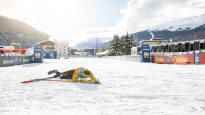Both men’s and women’s normal trips are competed in Davos. The competitions are significantly different from the other World Cup competitions in the early season, as they are skied over 1500 meters.
Today, Sunday, the 20-kilometer freestyle skiing World Cup competitions will be held in Davos. Both men and women start the race in almost 1600 meters with an intermediate start.
It is the height of the competition venue above sea level that creates exceptional conditions for performance compared to other competitions in the early season.
– The speed distribution must be reasonable in Davos, and the lap times should be even. Slumping at the beginning backfires many times over at high altitudes, ‘s skiing expert Ville Nousiainen opens the whole.
At high altitudes, the air pressure is lower than at sea level, which is why the air is thinner. When the partial pressure of oxygen decreases, the adaptation of the body is also different in athletes.
Nousiainen remembers well the first time she ever competed at a high altitude, specifically in Davos. The trail profile is gentle, which, according to the medalist of the race, invites you to ski hard.
– The first kilometer or so is a really gentle climb. I think I lead the whole race in the first interval. Then came death, Nousiainen laughs.
Davos is a demanding entity
After the start, the course continues in the same style for the next three kilometers, so a skier who starts too hard cannot recover at any point. The trail can also accommodate a few steeper uphill sections.
– When the acids jump, it’s a pretty wild journey to the finish line. When skiing at lower altitudes, even a small fall will restore you and you will get the situation under control, but at high altitudes it is much more difficult. Acids are not washed away, Nousiainen explains.
Because of this, the initial speed plays a big role. Nousiainen, who placed sixth at the best in the Davos World Cup, says that it would be easier to enter the competition cautiously if there was a drastic and steep climb at the beginning.
For example, after the start, Davos differs significantly from the normal distance races skied in Ruka in November. The beginning must be taken in moderation in both.
– After that, Ruka has to dare to hit the climbs practically full. In Davos, you have to stick your tongue in the middle of your mouth all the time, Nousiainen analysed.
Davos’ gentle slope also challenges downhill skiing. When you go up gently, you come down gently.
– Nowadays, you also have to ski downhill wassberg, mogren or pole skating. The skier does not get to ski at any point, but has to carry the ski all the time, Nousiainen sheds light on skiing techniques.
With these portions, the importance of pees is emphasized. In groups of several skiers, the last skier can save a lot of energy compared to the skier leading the group.
– It may be that you will be the last one to squat for long periods of time on the slopes, the expert points out.
According to Nousiainen, skiers who know their limits will do well in Davos. Skiers often learn through experience how to ski different track profiles. Even on Sundays, you may see big fluctuations in the rankings during the trip.
– At high altitude, you get a kind of full-body anesthesia when you’ve gone too hard. Then no limb moves anymore, even if there is a will. Even from a long way off, we can still be in the top three, Nousiainen states.
